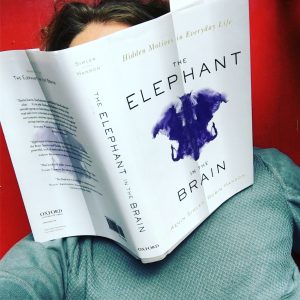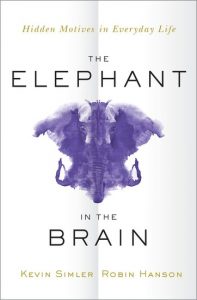Carolyn Chen argues in her new book Work Pray Code that Silicon Valley, one of the most vocally secular places in the world, has made their work into religion.
Nevertheless Unable to Escape Ourselves
 “We, human beings, are a species that’s not only capable of acting on hidden motives—we’re designed to do it,” write Kevin Simler and Robin Hanson in their new book The Elephant in the Brain: Hidden Motives in Everyday Life (Oxford University Press, 2018). “Our brains are built to act in our self-interest while at the same time trying hard not to appear selfish in front of other people.” It’s a compelling argument, largely because of cognitive dissonance: yes, I wholeheartedly agree that other people act based on self-interested motives, but when it comes to myself, no, I’m not so sure and in fact I’d like to deny that I’m motivated primarily by selfish urges. Well, let’s just rip off that bandage, shall we? We are all deceivers and self-deceivers, and it happens so constantly and so comfortably that it’s all but invisible when viewed from the inside of our skull.
“We, human beings, are a species that’s not only capable of acting on hidden motives—we’re designed to do it,” write Kevin Simler and Robin Hanson in their new book The Elephant in the Brain: Hidden Motives in Everyday Life (Oxford University Press, 2018). “Our brains are built to act in our self-interest while at the same time trying hard not to appear selfish in front of other people.” It’s a compelling argument, largely because of cognitive dissonance: yes, I wholeheartedly agree that other people act based on self-interested motives, but when it comes to myself, no, I’m not so sure and in fact I’d like to deny that I’m motivated primarily by selfish urges. Well, let’s just rip off that bandage, shall we? We are all deceivers and self-deceivers, and it happens so constantly and so comfortably that it’s all but invisible when viewed from the inside of our skull.
There are many uncomfortable truths of being human. This is probably the worst: that we are motivated nearly unfailingly by self-interest, a fact that is acted upon, then overwritten by our minds, so that we may preserve our sense of being “a good person” and better convince others of our benevolent qualities, too. It is such an uncomfortable truth that we cannot look at it unblinkingly. It is, to draw upon the metaphor of the title, the elephant in the brain whose presence is so dominant as to be undeniable, and yet, we don’t speak of it and rather pretend it’s not even there.
To be clear, we are not even referring to deliberate deception, but rather, the sleight of mind by which our brain decides what’s best, and then hands to our conscious selves the decision to defend. “You are not the king of your brain,” Steven Kaas is quoted as saying in the book. “You are the creepy guy standing next to the king going, ‘A most judicious choice, sire.’”
The authors take us on a journey through hidden motives in everyday life, including, ever so briefly:
- Body language, including our use of eye contact to assert dominance, and the plausible deniability it gives to us. “This is the magic of nonverbal communication. It allows us to pursue illicit agendas, even ones that require coordinating with other people, while minimizing the risk of being attacked, accused, gossiped about, and censured for norm violations.”
- The social value of talking and listening, and how we use them to generate prestige and alliances.
- The competitive signalling we participate in through our consumptive choices – like, what our decision to buy “green” products says about us to our peers, or what our ability to buy “exclusive” or “luxury” items says about us to those who cannot afford such things.
- Laughter as a means to show “the boundaries that language is too shy to make explicit.”
- The production of art, that is, a beautiful but effectively energy- and time-consumptive and functionless practice, as a display of our fitness.
The argument that Simler and Hanson make is rather comprehensive, and compelling. They bring together research on various topics of limited reach that, when combined, speak to the outrageous gall of the mind in recreating reality to its own liking, and then covering its tracks. Perhaps the most surprising element of it all is that they tell us nothing surprising: it’s all about survival and reproduction. Even for those who are, say, already married and past child-bearing age, or who have chosen a chaste life through divinity, there are still motivations for hiding your selfish motives: gaining friends or a community, for example, or the social proof of being kind and caring. The authors argue that, like the peacock’s plumage, we use different displays of personal value not in order to compete with other species, but to compete among ourselves for mates and resources (including allies).
If you’ve read books like Jonathan Haidt’s The Righteous Mind, or if you’ve followed the work of cognitive scientist Daniel Dennett or neuroscientist Sam Harris, or read Mesmerization by Gee Thomson or Cool by Steven Quartz and Anette Asp, what Simler and Hanson are saying feels like the next logical step in a current of thought that’s long on-going. It’s practically obvious. That is, it needed to be said. What stands out, however, is the futility of our awareness.
There is a section, “The Elephant in the Book,” whereby Simler and Hanson point out what must be, to the astute reader, increasingly obvious: the authors’ motivations. “To put it baldly, we want to impress you; we’re seeking prestige,” they write. They go on to explain how each will benefit from the publication of the book, Hanson as an academic, and Simler as an engineer who will get to have his name on a book cover. It is exactly the sort of admission that each of us would typically and easily suppress, because to admit vanity is unattractive; to admit ambition does not invite allies; to admit selfishness is to deter potential friends. Yet, we are all human. Generating a personal “value” and sharing that for others to see (no matter how publicly or intimately) are motivations that fuel all of us, the only difference is the extent to which we are aware of doing so.
The authors demonstrate, both literally and through perlocution, that we cannot outwit ourselves. The Elephant in the Brain comprises 300-plus pages of academic rigor on the magic tricks of the mind against—and for the benefit of—itself. Despite the fact that the human mind is capable of producing such an object—or any of countless brilliant works of science, art, or reason—our consciousness is still unable to get the upper-hand. We can consciously research and discuss the mind’s creative interpretations of the world, the way it plays fast and loose with information. We can wink to each other, knowingly, that our unconscious is really in charge, and we are nevertheless unable to escape ourselves. It is absurdity at a Shakespearean order.
The more we learn about the human mind, the more apparent that it’s something of a black box mystery. We cannot determine how our brain actually arrives where it does, we only experience the materialized outcomes: emotions and decisions. With black box software, we can reverse engineer its programmed functionality by throwing scenarios at it and seeing what it does, looking for patterns and errors. It’s clumsy and imperfect, but can get us quite far. Yet, as we continue to develop artificial intelligence, we will likely find ourselves recreating the phenomenon we see in our human minds—the complexity is so great, we cannot understand nor trace how it arrived where it did. We can see this already in action, for example, in the recent case of AI developing its own language that was incomprehensible to us. It’s evidence of the paradox we keep trying to construct: complex intelligence that is controllable.
The idea of taming the mind is, of course, a topic near and dear to the heart of Riding the Dragon, and so I arrive where I often do: creativity and intelligence are not to be domesticated; to thrive, they must be admired and respected for the feral animals that they are. So, while it is absurd that our rider can use refined language and logic to observe and report on the beast without ever becoming its master, the wisdom of accepting this enables them to work together in shared sympathy.
 The Elephant in the Brain is published by Oxford University Press.
The Elephant in the Brain is published by Oxford University Press.



